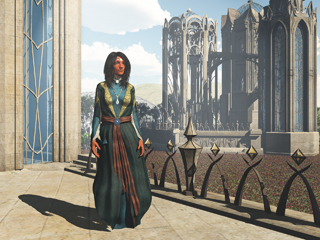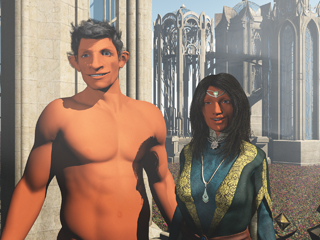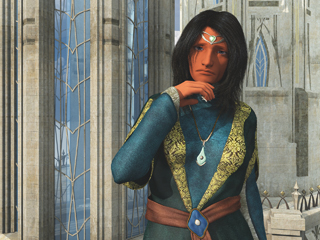 The readings explain that for all incarnation since that Atlantean lifetime, the two aspects of this soul entity were split into distinct individuals who had separate incarnations hencethorth, often (but not always) at the same time.
The readings explain that for all incarnation since that Atlantean lifetime, the two aspects of this soul entity were split into distinct individuals who had separate incarnations hencethorth, often (but not always) at the same time.On November 20, 1923 gave a reading for an eighteen year old stenographer, a young woman who was to become the personal secretary of Edgar Cayce. It was Gladys Davis who was said to have lived in Atlantis:
In the one before this we find in that fair country of Alta, or Poseidia proper, when this entity was in that force that brought the highest civilization and knowledge that has been known to the earth's plane, and this entity was one of those who lent much assistance to the developing of those forces that made the common peoples that they became the assistance in the knowledge as obtained. (288-1)
Subsequent follow-up readings went on to explain that the individual in this Atlantean incarnation (called Aczine) was feminine in appearance, yet somehow androgynous - both sexes in one body. So we find both the male and female aspects of the soul in one physical body with the female aspect more pronounced and the male aspect in the background, as it were.
 The readings explain that for all incarnation since that Atlantean lifetime, the two aspects of this soul entity were split into distinct individuals who had separate incarnations hencethorth, often (but not always) at the same time.
The readings explain that for all incarnation since that Atlantean lifetime, the two aspects of this soul entity were split into distinct individuals who had separate incarnations hencethorth, often (but not always) at the same time.
This almost sounds like Plato’s explanation of the soul splitting apart and thereafter seeking reunion. There are also some similarities to Jung’s theory of the animus and anima archetypes here as well. The Cayce readings use the term “twin souls” to describe the dynamic. Please note: This is not the same as “soul mates.”
In another reading for Ms. Davis that discusses the past life as Aczine, the entranced Cayce observes that:
… their soul and spirit are well knit, and must of necessity present each that they may be one. For we find in the beginning that they, these two (which we shall speak of as they until separated), were as one in mind, soul, spirit, body; and in the first earth's plane as the voice over many waters, when the glory of the Father's giving of the earth's indwelling of man was both male and female in one. In flesh form in earth's plane we find the first in that of the Poseidian forces, when both were confined in the body of the female; for this being the stronger in the then expressed or applied forces found manifestations for each in that form. (288-6)
 At this point in the story of Aczine the sexual eccentricity (by our modern standards) takes a more conventional turn. Aczine succumbs to lust: “the desire came for the bodily connection of coition with one of lower estate …” (288-6)
At this point in the story of Aczine the sexual eccentricity (by our modern standards) takes a more conventional turn. Aczine succumbs to lust: “the desire came for the bodily connection of coition with one of lower estate …” (288-6)
Another follow-up reading affirms the androgyny of Aczine:
(Q) In the Poseidian [Atlantis] period, just what was my position and vocation?
(A) A ruler, and what would be termed a DIVINER of purposes in the activities of the MENTAL life; for the PERIOD carried rather that of the MENTAL - that would be termed in the present day - of a PHYSICAL being; for then both male and female might be - desired so - in one. (288-27)
The entity was a ruler or DIVINER of the MENTAL life for this period or phase of Atlantean experience was a strongly mental expression. Was the body more of a thought form nature? Even though it is described as a “PHYSICAL being?” Note that both male and female might be in one – if desired so. It was a matter of choice.
(Q) In Atlantis, was I associated with Amilius? If so, how?
(A) One as projected by that entity as to a ruler or GUIDE for many, with its associating entity. (288-29)
This reading seems to indicate that Aczine was a projection of Amilius. Was this a thought form projection? If so, what about the soul? Note the expression “associating entity.” The concept is interesting in that the male component is regarded as its own entity. This suggests some extreme flexibility in the concept of the entity which is inherent in the idea of twin souls.
Yes, we have those conditions in the experience ... in Atlantis. Here we find as these conditions, or the changing of the entity's abilities in separating self in the form or manner in sex; hence becoming, with the associations, the envy of many then being contacted with the experiences as a leader, a ruler; hence, as given, meeting many conditions to its own undoing, considering little in the experience save the satisfying or aggrandizing of self's interests, self's gratifications, through those abilities in the use of that spirit, endowed with the abilities to bring into the material forms those thought forces even to the separation of self, in the satisfying of those elements in material forces for the satisfaction of self to the envy, to those conditions that brought much of the detrimental influences and forces in the experience of those about the body. (288-31)
 Thus this appears to have been some form of androgyny, although both male and female aspects were expressed through a feminine body: “both [aspects of sexual polarity] were confined in the body of the female; for this being the stronger.”
Thus this appears to have been some form of androgyny, although both male and female aspects were expressed through a feminine body: “both [aspects of sexual polarity] were confined in the body of the female; for this being the stronger.”
Note that a female body would allow for sexual androgeny wherein the progeneration within self may have been like the virgin birth experienced by Mary with Jesus. In other words this would not have involved the projection of a thought being.
This would make sense if Aczine later was tempted to indulge in sexual gratification with one of lower class. She had the sexual anatomy and physiology for such activity – it was simply a matter of choice as to how to express it. Apparently the choice to yield to the temptation of sexual relations had a negative impact on Aczine that carried over as karma into her twentieth century incarnation.